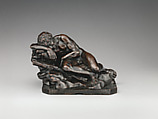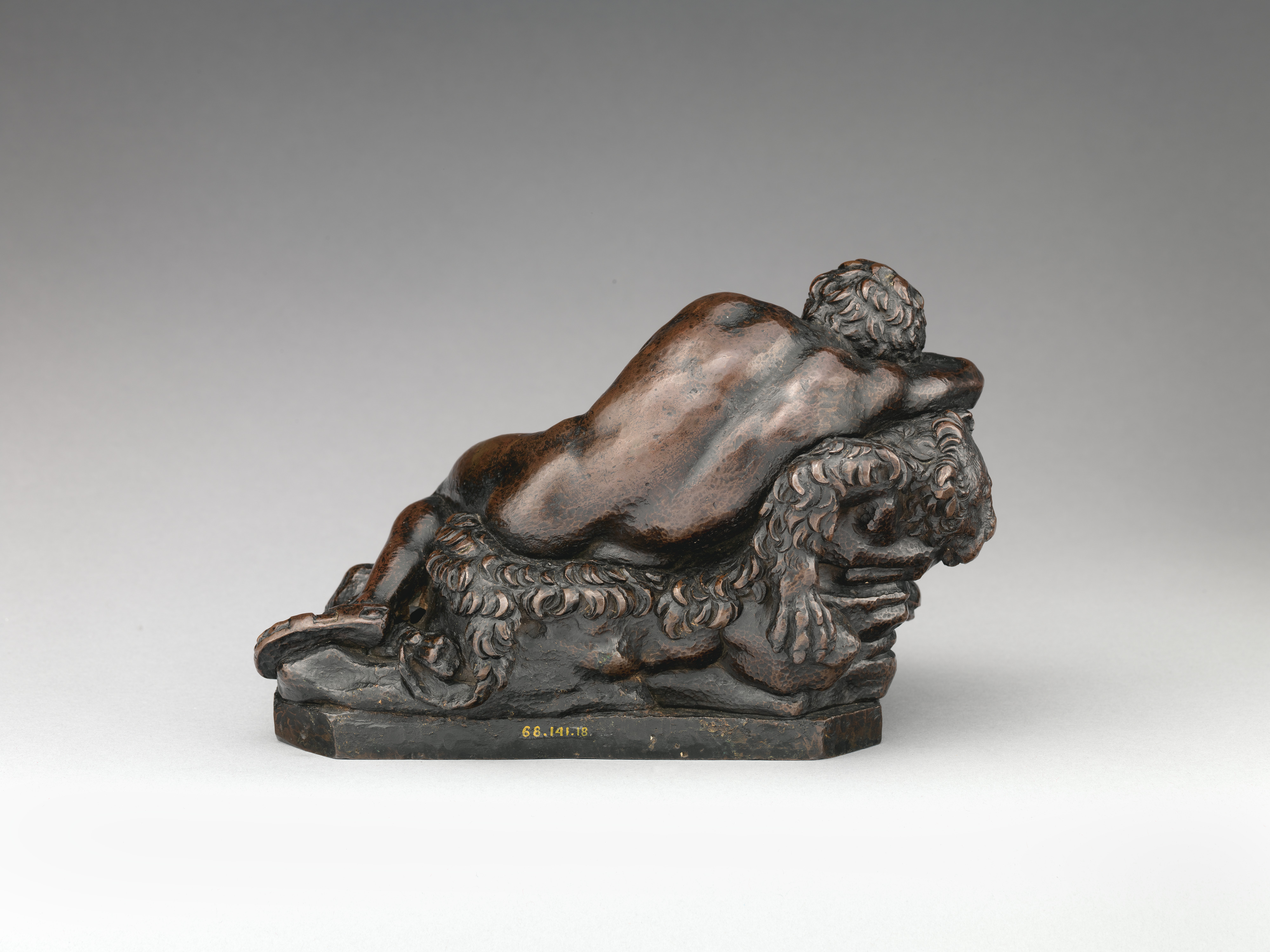Sleeping Hercules
Not on view
This evocative sculpture of Hercules sleeping on a rocky outcropping defies easy categorization. Although its subject is rare in Renaissance iconography, the bronze exhibits compelling relationships to several early sixteenth-century artworks, and its unusual facture and unclear use pose questions about its authenticity.
The heavy, directly cast bronze first appeared in the 1945 posthumous sale of the British banker Ernest G. Raphael and was owned by the Egyptian textile trader Fernand Adda, before being acquired by Judge Untermyer a few years before he gave a second tranche of his bronzes to the museum. Its surfaces appear heavily worked, with peening throughout the figure, attributes, and setting; broader shaping on the flat surfaces of the integral canted rectangular base; and broad chiseling to the uneven, hollowed underside. This and the obscure poetic subject, suggestive of humanist interest, have led it to be generally considered a work of the late fifteenth or early sixteenth century, of northern or central Italian origin.[1]
Michael Mezzatesta and Yvonne Hackenbroch connected the subject with the classical theme of the Choice or Dream of Hercules and, tenuously, with a late fifteenth-century German print source. Otherwise it has been assumed to represent the Resting Hercules, despite the fully reclined pose diverging from that subject’s main antique types, which are seated or standing. The bronze has a coincidental resonance with Andrea Verrocchio’s extraordinary terracotta Sleeping Youth of the 1470s in the Skulpturensammlung, Berlin, and likewise does not seem directly related to Baccio Bandinelli’s marble Sleeping Hercules of the 1550s in the Hermitage.[2] In eighteenth-century Great Britain, the subject of Sleeping Hercules found favor as decoration for chimneypieces.[3]
Reclined, sleeping figures were usually known in the Renaissance in the form of the Sleeping Nymph, and often found in the context of a fountain. The earliest and most notable example, the Vatican marble Cleopatra/Ariadne, was excavated and installed in the Belvedere sculpture court in 1512.[4] Another monumental marble Sleeping Nymph was installed in the large sculpture garden of Cardinal Rodolfo Pio da Carpi on the northern edge of the Quirinal Hill, begun in the 1540s. Long known through prints, the fragmentary statue has been identified in the Musei Capitolini and confirmed to be the work of a sixteenth-century sculptor in response to antique prototypes.[5] The composition was adapted to a small bronze now in the Vok collection catalogued as the work of an unknown artist in 1520s–30s Mantua (fig. 88a).[6] This bronze Nymph is disposed in a more linear, languid pose and in mirror orientation to our Hercules, but her hands are draped in relation to one another much like his.
The present sculpture exhibits its closest relationship in three dimensions to the bronze of a Sleeping Youth in the Ca’ d’Oro, Venice (fig. 88b).[7] That figure, nude except for shoes, is much younger and unaccompanied by attributes. James David Draper notes that the Ca’ d’Oro bronze also appears hammered all over, but is a lighter cast than the Hercules.[8] The Sleeping Youth can be traced back to the collection of Andrea Mantova Benavides, who, in 1695, described it as a work of Tiziano Aspetti. Malvina Benacchio argued in support of an attribution to the famous Paduan artist of that name, active in the later sixteenth century; however, she also pointed out that seventeenth-century authors regularly confused Aspetti’s identity with an earlier sculptor of the same name, called “Minio,” who was active in Jacopo Sansovino’s workshop in the first half of the century.[9] The idea of connecting the Ca’ d’Oro bronze, and thus our sculpture, to Tiziano Minio becomes particularly intriguing in light of another reclined figure on an integral base of the same scale now in the Rijksmuseum, which exhibits the same surface and similarly conceived physiognomy as the Sleeping Hercules.[10] However, Minio’s independent output is not well documented and his corpus is not securely constructed, making attributions on stylistic grounds difficult.
The exact composition and subject of our Hercules are found together in only one other artwork known to this author, appearing as a fictive metal relief in the fresco cycle executed by Amico Aspertini and other artists on the walls of the Oratorio di Santa Cecilia, Bologna, in 1505–6 (fig. 88c).[11] It is painted as a prominent decorative panel at the foot of the throne of Almachius, from which he orders the torture and execution of Saint Cecilia. The sleeping figure is shod with sandals and accompanied by a club, depicted in the monochrome red palette often used across Italy in this period to represent metallic relief sculpture, frequently in archaizing contexts like this.[12]
This Bolognese connection is most interesting in light of recent scholarship on small bronzes made in that city. Jeremy Warren identifies a Sleeping Hercules inscribed with praise to the collector Gaspare Fantuzzi as “one of very few Renaissance bronzes which can with some confidence be said to have been made in Bologna,” and dates it to around 1500 (fig. 88d).[13] The Fortnum Venus, which Warren has attributed to the Bolognese artist Francesco Francia and dated circa 1495–1505, has a similarly peened surface, which could suggest such texturing was a desirable feature of small bronzes in Bologna and Ferrara at that time.[14]
Comparisons pointing in multiple directions—to Florence, Bologna, Rome, and the Veneto—along with the appearance of a heavily worked surface, which could indicate a retardataire style, leave open the possibility that The Met’s Sleeping Hercules was made in a much later era, to deceive, using the Ca’ d’Oro relief or the Santa Cecilia fresco as a compositional point of departure.
-PJB
Footnotes
(For key to shortened references see bibliography in Allen, Italian Renaissance and Baroque Bronzes in The Metropolitan Museum of Art. NY: The Metropolitan Museum of Art, 2022.)
1. In addition to the attributions to followers of Bertoldo and Bellano in the auction catalogues, James David Draper (MMA 1975, p. 238) first catalogued it as “about 1500, north Italian” and then Florentine, last quarter of the 15th century, noting “limited similarities” in facture and composition to a Hercules with the Nemean Lion in the V&A (A.77:0-1910), given to Giovanni Rustici (Untermyer 1977, p. 157). (The old attribution of the V&A bronze to Rustici would probably not stand up in light of recent scholarship on the artist.) Mezzatesta 1976 implicitly accepted Draper’s earlier attribution, while Hackenbroch 1976 attributed it to Peter Vischer the Younger, 1520–25.
2. Skulpturensammlung, 112; Hermitage, Н.CK-1669.
3. Several chimneypiece relief sculptures associated with Michael Rysbrack have appeared at auction: Sotheby’s, New York, April 26, 2008, lot 134; Christie’s King Street, London, July 9, 2009, lot 54; Sotheby’s, London, December 8, 2009, lot 67.
4. See MacDougall 1975.
5. Mocci 1986.
6. Banzato 2004, pp. 64–67, cat. 21.
7. Further study—ideally direct comparison—is needed to determine whether a model-cast relationship exists between the bronzes.
8. Untermyer 1977, p. 157.
9. Benacchio 1934–39, pp. 92–97.
10. Riksmuseum, BK-1954-44; see Scholten and Verber 2005, pp. 62–63, cat. 15.
11. Gadda and Stivani 2006, pp. 50–51.
12. See, for example, Sandro Botticelli’s Calumny of Apelles, ca. 1497 (Uffizi), or the lower zones of Raphael’s Stanze in the Vatican, conceived in 1508–9.
13. Warren 2007, pp. 833–34.
14. Ashmolean, WA1899.CDEF.B411; see Warren 1999a, p. 220, Warren 1999b, pp. 56–57, cat. 14; Warren 2014, pp. 76–82, cat. 20.
Due to rights restrictions, this image cannot be enlarged, viewed at full screen, or downloaded.
This artwork is meant to be viewed from right to left. Scroll left to view more.



